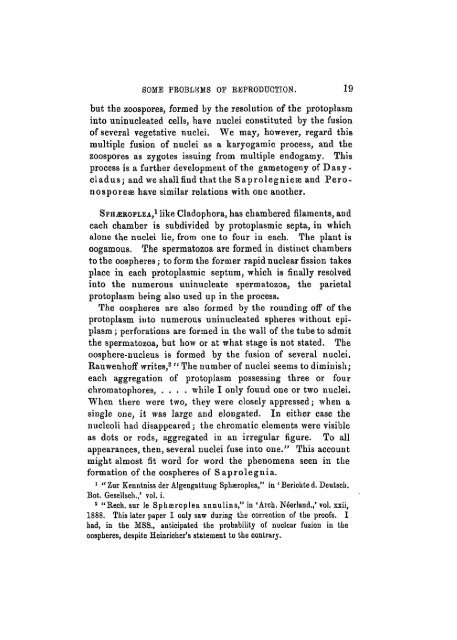Some Problems of Reproduction: a Comparative Study of ...
Some Problems of Reproduction: a Comparative Study of ...
Some Problems of Reproduction: a Comparative Study of ...
Create successful ePaper yourself
Turn your PDF publications into a flip-book with our unique Google optimized e-Paper software.
SOME PROBLUMS OF REPRODUCTION. 19<br />
but the zoospores, formed by the resolution <strong>of</strong> the protoplasm<br />
into uninucleated cells, have nuclei constituted by the fusion<br />
<strong>of</strong> several vegetative nuclei. We may, however, regard this<br />
multiple fusion <strong>of</strong> nuclei as a karyogamic process, and the<br />
zoospores as zygotes issuing from multiple endogamy. This<br />
process is a further development <strong>of</strong> the gametogeny <strong>of</strong> Dasycladus;<br />
and we shall find that the Saprolegniese and Peronosporese<br />
have similar relations with one another.<br />
SPHJE&OPLEA, 1 like Cladophora, has chambered filaments, and<br />
each chamber is subdivided by protoplasmic septa, in which<br />
alone the nuclei lie, from one to four in each. The plant is<br />
oogamous. The spermatozoa are formed in distinct chambers<br />
to the oospheres; to form the former rapid nuclear fission takes<br />
place in each protoplasmic septum, which is finally resolved<br />
into the numerous uninucleate spermatozoa, the parietal<br />
protoplasm being also used up in the process.<br />
The oospheres are also formed by the rounding <strong>of</strong>f <strong>of</strong> the<br />
protoplasm into numerous uninucleated spheres without epiplasm;<br />
perforations are formed in the wall <strong>of</strong> the tube to admit<br />
the spermatozoa, but how or at what stage is not stated. The<br />
oosphere-nucleus is formed by the fusion <strong>of</strong> several nuclei.<br />
Rauwenh<strong>of</strong>f writes, 3 " The number <strong>of</strong> nuclei seems to diminish;<br />
each aggregation <strong>of</strong> protoplasm possessing three or four<br />
chromatophores, .... while I only found one or two nuclei.<br />
When there were two, they were closely appressed; when a<br />
single one, it was large and elongated. In either case the<br />
nucleoli had disappeared; the chromatic elements were visible<br />
as dots or rods, aggregated in an irregular figure. To all<br />
appearances, then, several nuclei fuse into one." This account<br />
might almost fit word for word the phenomena seen in the<br />
formation <strong>of</strong> the oospheres <strong>of</strong> Saprolegnia.<br />
1<br />
"Zur Kenntniss der Algengattung Sphseroplea," in ' Berichte d. Deutsch.<br />
Bot. Gesellsch./ vol. i.<br />
2<br />
"Recli. sur le Sphseroplea annulina," in 'Arch. Norland.,' vol. xxii,<br />
1888. This later paper I only saw during the correction <strong>of</strong> the pro<strong>of</strong>s. I<br />
had, in the MSS., anticipated the probability <strong>of</strong> nuclear fusion in the<br />
oospheres, despite Heinricher's statement to the contrary.

















